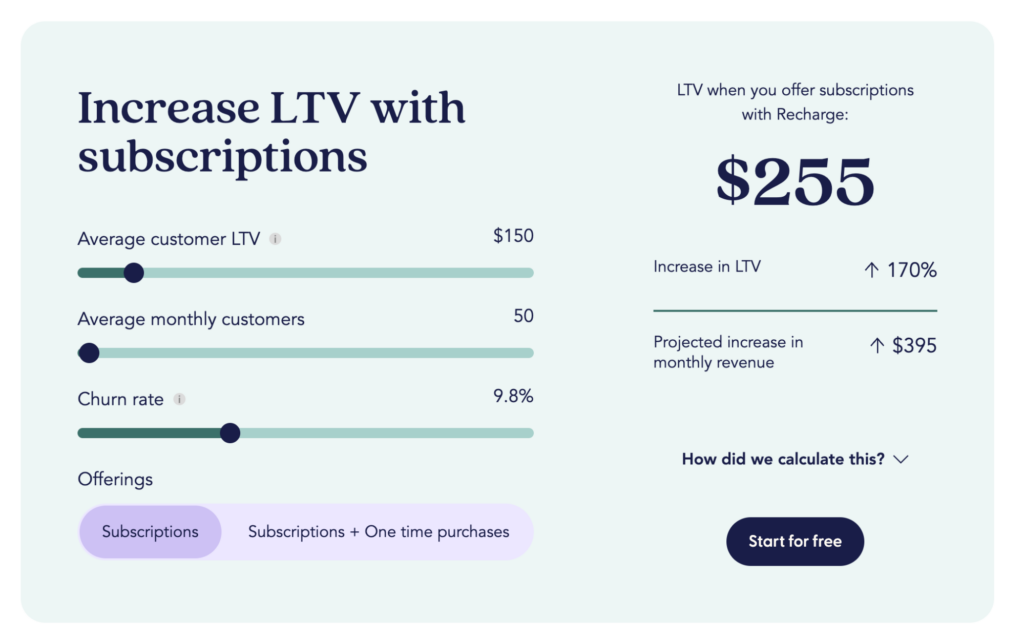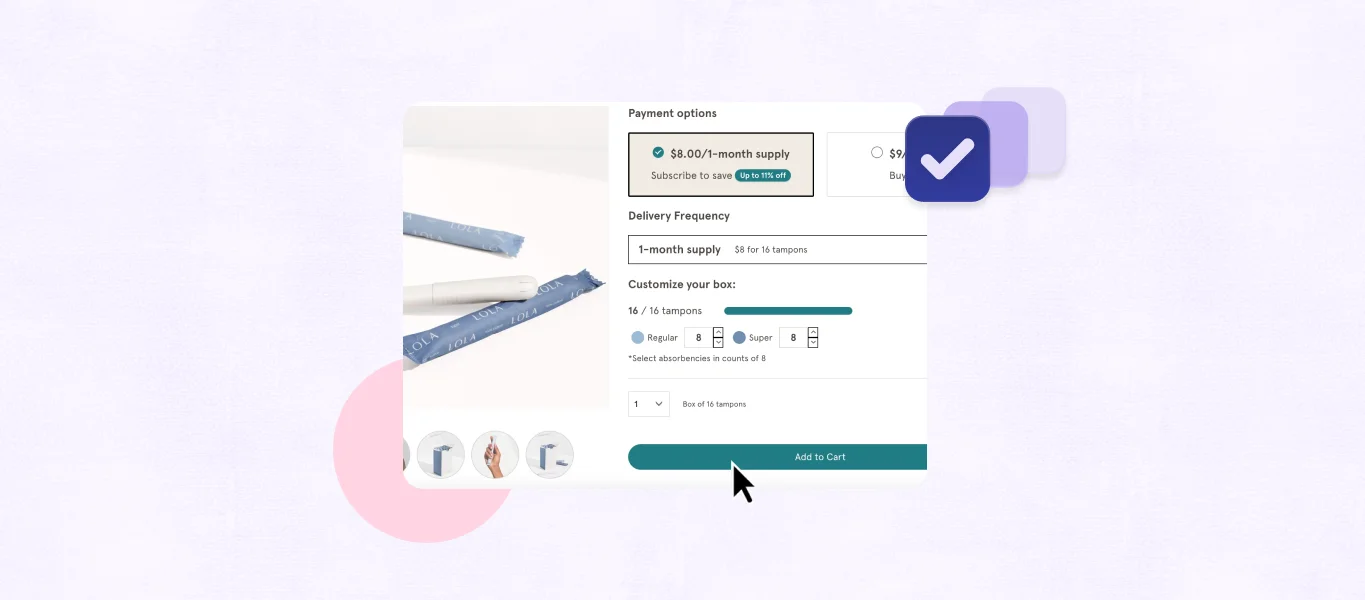Online stores looking to increase their customer lifetime value (LTV) and grow customer loyalty should consider developing a subscription business model. It’s no secret that subscription businesses form stronger relationships with their customers, leading to reliable recurring revenue and lower customer acquisition costs (CAC).
But where does an ecommerce business start? Subscription models require the right subscription software in order to provide a top customer experience for subscribers. Selecting the best subscription management solution is just the beginning—from there, online stores can take their subscription offerings to the next level with a seamless customer journey and customizable subscription choices for shoppers.
Key takeaways
- Businesses considering a subscription model should learn more about the process for setting up subscriptions, like choosing a subscription ecommerce platform.
- The subscription economy is expected to grow significantly in the coming years, making it a great time to consider enabling subscriptions for your online store.
- Subscription services give merchants access to the recurring revenue model—leading to monthly recurring revenue for businesses.
What is a subscription business model?
Let’s explore what it means to become a subscription business. This type of business model allows merchants to sell a product or service on a recurring basis. Whether you offer subscription boxes full of items like dog toys, or a subscription service such as monthly dog grooming, the main goal of the subscription revenue model is to charge customers at a regular cadence.
With the ecommerce subscription model, the focus is less on customer acquisition and more on retaining existing customers. Of course, subscription businesses will need to acquire customers as they build strong customer relationships with their current subscribers, but thanks to the cyclical nature of subscriptions, they won’t have to spend as much time on customer acquisition as stores that only offer one-time purchases do.
Benefits of a subscription model
There are so many benefits of the subscription-based revenue model that merchants can take advantage of when they start offering subscriptions. Not only will you be able to better nurture your customer relationships, but you can also expect easier financial forecasting and inventory management. With recurring revenue, there’s less guesswork about how much profit your business will make in a given quarter, plus it’s easier to know how much supply you’ll need when customers are set up with subscriptions at specific intervals.
Here are a few more benefits of subscriptions that merchants can enjoy:
- Reliable recurring revenue
- Increased customer loyalty and strong customer base
- Reduced churn and better customer retention
- Increased customer lifetime value
- Higher customer engagement
- Lower customer acquisition costs
- Better financial forecasting
- More predictable inventory management

How to develop a subscription business model
Once a merchant has decided they would like to become a subscription business, then it’s time to develop their subscription business model into a real offering—whether it’s a product or service. Once you’ve created a business plan and chosen a subscription management solution, you’ll be on your way to predictable revenue in no time. Plus, existing customers will be excited to learn about your new offerings, which could add a level of ease and convenience to their shopping experience.
1. Decide which kind of subscriptions you would like to offer
The first step in developing your subscription business is to decide which products or services you would like to offer on subscription. Within the subscription business model, there are a few different types to consider. Depending on your ecommerce store, one model or a combination of models will make the most sense for you.
The different types of subscription business models are:
- Curation: Merchants curate a box of one or more products, put them in a package together, and ship them to the customer. This is the most popular choice among subscription box businesses.
- Replenishment: Sometimes referred to as “subscribe-and-save,” this model is often used when merchants offer a discount to their repeat customers. It is the best option for products that people use frequently since it offers the same product on a regular basis.
- Access: The third type of subscription model offers exclusive access to discounts, early releases, gated content, and more. It also includes memberships.
2. Select a subscription management solution
An essential aspect of subscription businesses is how you manage subscriptions, including how you allow your customers to manage their own subscriptions. This is where subscription ecommerce solutions come into play. These software solutions give online stores the ability to sell their products online, at a recurring cadence, while also enabling customers and merchants to manage their subscriptions—such as renewing, pausing, or canceling their services.
One of the most important steps in developing a subscription business model is to choose the right subscription management software for your business. Our new interactive guide shares the major components of subscription ecommerce platforms, helping merchants choose the best one based on their individual needs.
3. Choose a subscription pricing structure
Once you have a subscription software platform and are ready to start making subscriptions available, it will be crucial to set the right pricing for your offerings. Subscription pricing often comes with a discount to subscribers, because brands want to thank customers for their loyalty. Many merchants also consider offering free shipping to subscribers, or other perks that make signing up for a subscription more appealing.
4. Create a seamless user experience
To keep subscribers happy, your subscription business will need a seamless customer experience that makes it clear and easy for customers to edit their orders or even cancel their subscription if they need to. Maintaining strong customer relationships is easier when shoppers feel valued and have a great experience, from the minute they discover your brand to after they make a purchase. No matter how you acquire customers, you’ll want to keep them happy so they stick around longer.
5. Make billing simple
Keeping customer retention high also includes easy billing. The subscription revenue model gives merchants access to predictable revenue—but the terms for subscribers should be straightforward and easy to understand. Recurring payments can happen on a weekly, monthly, yearly, or custom cadence, it will just depend on which product or service you are offering.
Subscription companies that charge their customers at an interval that makes sense will gain customer appreciation and increase customer retention. If you’re asking customers to pay too frequently, they might get scared off by the number of charges on their credit cards.
6. Integrate additional tools & features
Subscription businesses differ greatly from those that only offer one-time purchases—not only do subscription companies need to strive to create customer loyalty, but they also have to make managing subscriptions easy for their customers. Integrating additional tools, like transactional text messaging, will make your customer journey seamless, leaving you with happy subscribers who are empowered to manage their subscriptions on their own.
The power of subscription business models
If your business is considering adopting the subscription model and relying on predictable revenue, now is a great time to start developing your subscription offerings. By selecting the right subscription ecommerce platform and creating a smooth customer journey, you can keep subscribers happy and expect to spend less money on customer acquisition costs. Instead, you can focus your efforts on your existing customer base and giving subscribers a seamless experience.
Sources
[1] How to choose your subscription management solution (Recharge)
[2] 7 benefits of the subscription model (Recharge)
[3] How do you start a subscription box? (ecommerce for beginners) (Recharge)
[4] Simplify the subscriber experience with RechargeSMS (Recharge)
[5] CAC (customer acquisition cost) (Recharge ecommerce glossary)



